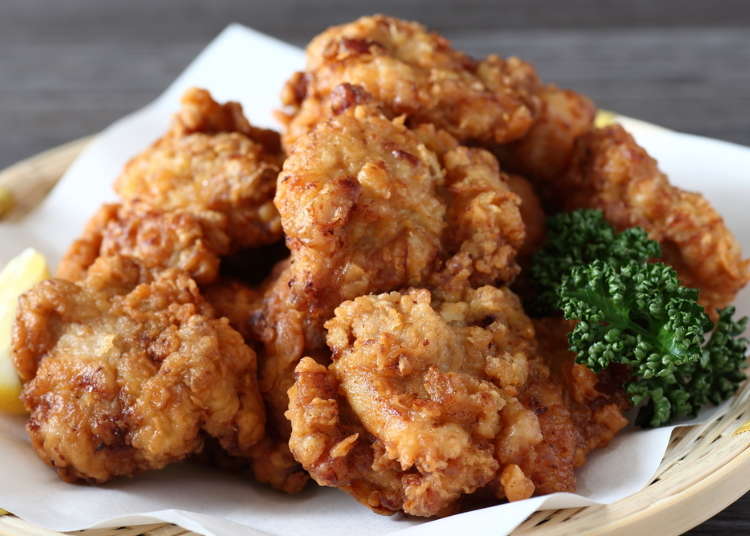
What’s the Difference Between 'Karaage' and 'Tatsutaage'? We Asked a Pro About These Classic Japanese Dishes
- Written by: Naho Jishikyu
In traditional Japanese cuisine, there are many dishes that seem similar but have different names. For example, "Karaage" and "Tatsutaage," or "Sashimi" and "Otsukuri." Surprisingly, few people can clearly explain the differences between them.
This time, we investigated the differences in these classic Japanese dishes. We spoke with Kuniko Sugisaki, a registered dietitian and instructor at Musashino Nutrition College, to learn more.
Do "Tsukune" and "Tsumire" Differ Based on the Dishes They're Used In?
"Tsukune" and "Tsumire" might look similar at first glance. You might think the only difference is the ingredients, but it turns out the distinction lies in the cooking methods.

"Tsukune" comes from the word meaning "to knead by hand into a round shape." It is made by finely chopping or mincing pork, chicken, or other meats, and then mixing them with binding ingredients like eggs until sticky. Sometimes, vegetables are also added before shaping the mixture into balls. Tsukune can be cooked by boiling, grilling, or frying.
On the other hand, "Tsumire" comes from the term "tsumiire," meaning "to pinch and put into broth." It is made by shaping the prepared mixture by hand or with a spoon into bite-sized pieces, which are then added to boiling water or soup to cook.
Typically, Tsumire is made from fish paste combined with egg whites or potato starch as binders, and sometimes includes ingredients like yam or tofu. You often hear of "tsumire soup," but "tsukune soup" is less common.
"Tatsutaage" is a Type of "Karaage" - The Key Difference Lies in the Seasoning!
Both dishes involve coating and frying ingredients, but what exactly sets them apart?

"Karaage" is a general term for foods that are marinated and then coated with a batter before frying, similar to how "nimono" refers to various simmered dishes like Chikuzenni or Nikujaga. There are two main methods of preparation: marinating the meat, seafood, or vegetables before coating them in flour (typically potato starch or wheat flour) and frying, or incorporating various seasonings directly into the batter. The term "唐揚げ" (karaage) reflects its Chinese origins, and garlic is often used in the seasoning.
"Tatsutaage," on the other hand, is named after the Tatsuta River in the Ikoma region of Nara Prefecture, famous for its autumn foliage. This method involves marinating the meat or fish, but not seasoning the coating (mainly potato starch) before frying. The thicker white coating and the reddish-brown parts resemble the leaves floating on the river, capturing the essence of autumn.
"Tatsutaage" is indeed a type of "Karaage," prepared using one of its variations. Unlike karaage, tatsutaage is a Japanese creation that typically doesn't use garlic. Instead, it relies on a marinade of soy sauce and mirin.
Regional Differences in the Names "Sashimi" and "Otsukuri"
"Sashimi" and "Otsukuri" (or "Tsukuri") are quintessential Japanese dishes that involve eating raw seafood. While they may look the same, understanding the meanings behind these terms reveals their differences.

"Sashimi" and "Otsukuri" (or "Tsukuri") are quintessential Japanese dishes that involve eating raw seafood. While they may look the same, understanding the meanings behind these terms reveals their differences.
"Sashimi" was originally called "sashimi namasu." The term "namasu" refers to dishes that involve eating raw meat or fish with seasonings. In addition to seafood, chicken, beef, horse meat, and even konnyaku can be considered "sashimi." The term "tsukuri" comes from the word "to cut" (造る or 作る), which was used to describe the preparation of fish.
"Sashimi" is commonly used in the Kanto region, while "Tsukuri" is more frequently used in Kansai, where it is often referred to with the polite prefix "o" as "Otsukuri." During the samurai era, the word "sasu" (to pierce) was considered unlucky, leading to the use of "Otsukuri" instead.
There are various preparation styles, such as hira-zukuri (standard cut), usu-zukuri (thin cut), kaku-zukuri (cube cut), arai (washed in cold water), yubiki (blanched), and kombu-jime (marinated with kelp). "Arai" refers to thinly slicing or shredding fish and washing it in ice water, which firms up the flesh and removes some fat, making it a light and refreshing dish perfect for summer. It is often enjoyed with karashi miso, karashi soy sauce, or plum soy sauce.
"Tataki" refers to ingredients that are pounded with the side of a knife, pestle, or hand, or finely chopped with a knife. The method of "tataku" (to pound) gives the dish its name. "Tataki" can also refer to lightly seared blocks of fish like bonito, which are garnished with ingredients such as green onions, ginger, shiso, and garlic.
Difference Between "Nikomi Udon" and "Nabeyaki Udon" Lies in the Preparation
Both "Nikomi Udon" and "Nabeyaki Udon" are warm udon dishes cooked with a variety of ingredients, but their preparation methods set them apart.

"In Nikomi Udon, the noodles, ingredients, and broth are heated separately and then combined in the bowl. Typical examples include Nagoya's miso nikomi udon and Yamanashi's houtou. Some restaurants, similar to home cooking, heat the ingredients in dashi broth, season to taste, add the udon, and then finish cooking by simmering everything together."
On the other hand, "Nabeyaki Udon," a type of Nikomi Udon, originated in Osaka towards the end of the Edo period. The term "nabe-yaki" comes from the practice of hanging a pot over a hearth and cooking the ingredients directly over the fire, referred to as "yaki" (grilling or baking).
"The cooking method involves placing all the ingredients in the pot and simmering them together. Typically, a shallow clay pot is used, where dashi broth, udon noodles, shiitake mushrooms, kamaboko, vegetables, shrimp tempura, and an egg are added on top and cooked together. The highlight of Nabeyaki Udon is enjoying it straight from the pot while it's still bubbling hot."
Are There Differences Between "Oshinko," "Tsukemono," and "Konomono"? Surprisingly, Not Really!
"Tsukemono" (pickles) are an essential part of Japanese cuisine. Depending on the restaurant, you might see them referred to as "Oshinko," "Konomono," or simply "Tsukemono" on the menu. Many people might wonder what the differences are between these terms.

In reality, "Oshinko," "Konomono," and "Tsukemono" all refer to the same thing: pickled vegetables. The terms "Oshinko" and "Konomono" are just more refined expressions of "Tsukemono."
"The history of Tsukemono dates back about 2,000 years. Monks in temples used to salt-pickle vegetables like eggplant, cucumber, and peaches, enjoying various vegetables seasonally. Initially, only salt was used, but eventually, miso, sake, soy sauce, and other seasonings were also used. Miso, in particular, was highly aromatic and was called 'ko,' which led to the term 'kokou' for miso pickles during the Muromachi period, influencing the modern terminology."
During the Edo period, while previously people preferred long-pickled vegetables, they started favoring vegetables pickled for just one night. This shift led to the terms "Shinko" (new pickles) and "Oshinko" (honorable new pickles). The different names can make them seem like entirely different foods, showcasing the fascinating nuances of the Japanese language.
Naho has been working as an editor and writer for over 17 years. After editing various materials such as manga, novels, and magazines, she became a freelancer. She is skilled in reporting and writing about food, sightseeing, and drama reviews while also providing web strategy consulting for food and beverage companies. As a result, she is always up-to-date on new products and trends in Japanese cuisine and conveys them in an understandable manner to people of all ages and nationalities through LIVE JAPAN.
- Category
*Prices and options mentioned are subject to change.
*Unless stated otherwise, all prices include tax.
Popular Tours & Activitiess
Recommended places for you
-

BUDDY BUDDY
Other Restaurants
Sapporo / Chitose
-

TOKYO KAIKAN
Other Restaurants
Ginza
-

Birthday Surprise x KUJIRA ENTERTAINMENT DINING
Other Restaurants
Shinjuku
-

fes Fuesu
Other Restaurants
Umeda, Osaka Station, Kitashinchi
-

PASELANamba
Other Restaurants
Namba, Dotonbori, Shinsaibashi
-

Man in the MoonKarasuma
Other Restaurants
Gion, Kawaramachi, Kiyomizu-dera Temple
-

First Japan Cherry Blossom 2026 Forecast Announced! Here's When & Where to See Sakura in Japan
-
Ad

(Opening in Jan 2026) 'THE SUMO LIVE RESTAURANT HIRAKUZA GINZA TOKYO!' 5 Exciting Ways to Experience the World of Sumo!
-

This Winter, Godzilla Takes Over Haneda Airport
by: Guest Contributor
-

How to Get Don Quijote's Exclusive 2025-2026 Winter Gift (+Tax-Free Savings)
-

Strawberries, Style, and Tokyo’s Coolest Neighborhood: Winter Afternoon Tea in Kichijoji
by: Guest Contributor
-

New in Ginza! Air BicCamera Ginza Opens with a Faster, More Convenient Shopping Experience
by: Guest Contributor
-

38 Best Things to Do in Kyoto: See, Eat, and Shop Your Way Through Japan's Cultural Capital
-

Delicious, Convenient, and Cheap! 5 Must-Try 7-Eleven Sweets!
by: Naho Jishikyu
-

Bonenkai and Shinnenkai: Japan’s New Year’s Work Parties that Will Have You Forget the Last Year and Welcome the Next!
-

What Are the Top 3 Must-Eat Foods in Japan? We Asked 50 Tourists for Their Recommendations
-

Sapporo Station Food: Top 10 'Hokkaido Ekiben' Bento Boxes You Must Try Before Riding the Rails!
-

Oga Aquarium GAO Guide: Fish, Polar Bears and...Godzilla?
- #best sushi japan
- #what to do in odaiba
- #what to bring to japan
- #new years in tokyo
- #best ramen japan
- #what to buy in ameyoko
- #japanese nail trends
- #things to do japan
- #onsen tattoo friendly tokyo
- #daiso
- #best coffee japan
- #best japanese soft drinks
- #best yakiniku japan
- #japanese fashion culture
- #japanese convenience store snacks













